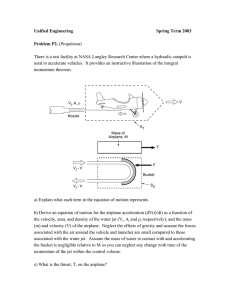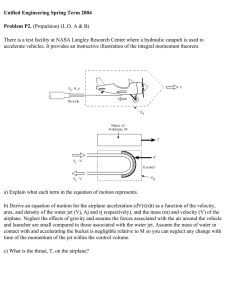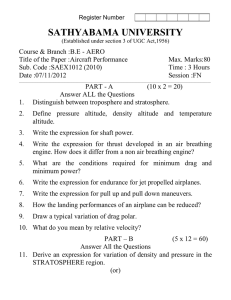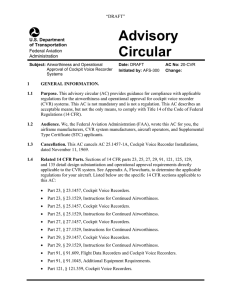IP Based Aviation Networks
advertisement
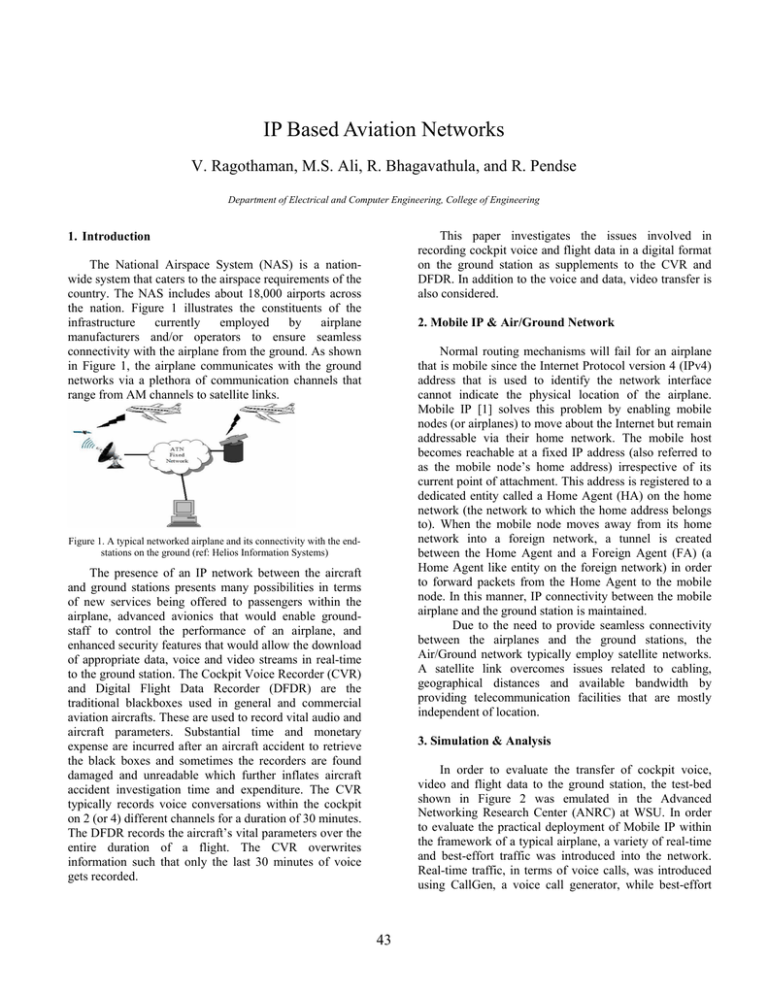
IP Based Aviation Networks V. Ragothaman, M.S. Ali, R. Bhagavathula, and R. Pendse Department of Electrical and Computer Engineering, College of Engineering This paper investigates the issues involved in recording cockpit voice and flight data in a digital format on the ground station as supplements to the CVR and DFDR. In addition to the voice and data, video transfer is also considered. 1. Introduction The National Airspace System (NAS) is a nationwide system that caters to the airspace requirements of the country. The NAS includes about 18,000 airports across the nation. Figure 1 illustrates the constituents of the infrastructure currently employed by airplane manufacturers and/or operators to ensure seamless connectivity with the airplane from the ground. As shown in Figure 1, the airplane communicates with the ground networks via a plethora of communication channels that range from AM channels to satellite links. 2. Mobile IP & Air/Ground Network Normal routing mechanisms will fail for an airplane that is mobile since the Internet Protocol version 4 (IPv4) address that is used to identify the network interface cannot indicate the physical location of the airplane. Mobile IP [1] solves this problem by enabling mobile nodes (or airplanes) to move about the Internet but remain addressable via their home network. The mobile host becomes reachable at a fixed IP address (also referred to as the mobile node’s home address) irrespective of its current point of attachment. This address is registered to a dedicated entity called a Home Agent (HA) on the home network (the network to which the home address belongs to). When the mobile node moves away from its home network into a foreign network, a tunnel is created between the Home Agent and a Foreign Agent (FA) (a Home Agent like entity on the foreign network) in order to forward packets from the Home Agent to the mobile node. In this manner, IP connectivity between the mobile airplane and the ground station is maintained. Due to the need to provide seamless connectivity between the airplanes and the ground stations, the Air/Ground network typically employ satellite networks. A satellite link overcomes issues related to cabling, geographical distances and available bandwidth by providing telecommunication facilities that are mostly independent of location. Figure 1. A typical networked airplane and its connectivity with the endstations on the ground (ref: Helios Information Systems) The presence of an IP network between the aircraft and ground stations presents many possibilities in terms of new services being offered to passengers within the airplane, advanced avionics that would enable groundstaff to control the performance of an airplane, and enhanced security features that would allow the download of appropriate data, voice and video streams in real-time to the ground station. The Cockpit Voice Recorder (CVR) and Digital Flight Data Recorder (DFDR) are the traditional blackboxes used in general and commercial aviation aircrafts. These are used to record vital audio and aircraft parameters. Substantial time and monetary expense are incurred after an aircraft accident to retrieve the black boxes and sometimes the recorders are found damaged and unreadable which further inflates aircraft accident investigation time and expenditure. The CVR typically records voice conversations within the cockpit on 2 (or 4) different channels for a duration of 30 minutes. The DFDR records the aircraft’s vital parameters over the entire duration of a flight. The CVR overwrites information such that only the last 30 minutes of voice gets recorded. 3. Simulation & Analysis In order to evaluate the transfer of cockpit voice, video and flight data to the ground station, the test-bed shown in Figure 2 was emulated in the Advanced Networking Research Center (ANRC) at WSU. In order to evaluate the practical deployment of Mobile IP within the framework of a typical airplane, a variety of real-time and best-effort traffic was introduced into the network. Real-time traffic, in terms of voice calls, was introduced using CallGen, a voice call generator, while best-effort 43 traffic was introduced through PaGent, a packet generation tool. CallGen and PaGent are Cisco Systems proprietary tools for voice and data packet generation. CallGen was used to generate voice calls on 4 channels, in accordance with the fact that a CVR records voice on 2 or 4 channels. Three different voice codecs, namely, G.711, G.726 and G.729 were chosen. Routers running Pagent were used to generate data traffic from both the Control and Passenger Networks. simulations, it was determined that the aircraft parameters could be stored at ground stations in a digital format. 4. Conclusion & Future work Based on the results obtained, it can be said that the transfer of real-time voice, real-time video and data simultaneously is feasible. However, further investigations need to be carried out in areas pertaining to quality estimation. A scenario requiring multitudes of airplanes transmitting voice, video and data to a ground station would require a more comprehensive and scalable solution than the ones that have been considered so far. Another important aspect that will be looked into is the integration of Internet Protocol version 6 (IPv6) into the network to keep up with the changes to the Internet in the future. MOBILE NETWORK DATA STORAGE CN SATELLITE LINK HN FN INTERNET GROUND STATION 5. Acknowledgements GROUND STATION This work was supported in part by Cessna Aircraft Inc., the State of Kansas, NIAR and Cisco Systems. Many thanks are due to the engineers at these organizations for providing valuable insights into the interaction of aviation related components with networking elements. Figure 2. Aviation network test-bed setup The CN data traffic was generated at the rate of 8.8 Kbps, while the PN data traffic was generated at a rate of 1.06 Mbps. The combined generation rates were selected randomly such that the total traffic generation exceeded 1.544 Mbps, which is the bandwidth of the satellite link. A Video Capture application to capture the incoming video stream at the client end was developed. The application, based on the popular Windows Media Encoder was written in Visual Basic. Each set of simulations were run with varying voice codec and video bandwidth. The analysis of results from some of these simulations is presented next. 6. Reference [1] C.Perkins, “Mobile Networking through Mobile IP”, IEEE Internet Computing, Jamuary 1998 Simulations showed that packet drop percentages linger around the 2% mark indicating that these packet drops occur mostly at the Satellite link between the Mobile Network (Aircraft) and the Foreign Network (ground station), which was configured to drop 2% of all traffic passing through it. This 2 % drop was found to be consistent while using G.726 and G.711 codecs. An important factor to be considered in the presence of real-time traffic is the associated end-to-end delay. This delay can be attributed to coding delay, propagation delay, queuing delay and the network delay. If a real-time traffic packet delay exceeds 150 ms, it is considered to be of no use since any delay over 150 ms would be noticeable during the course of a conversation (for example, voice conversation), and hence that packet would have to be discarded. This factor adds to the number of packet drops since the Satellite link is also configured to delay packets passing through it. Through 44
